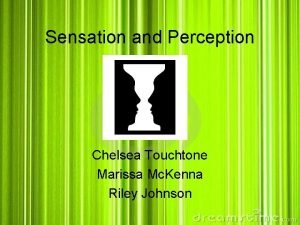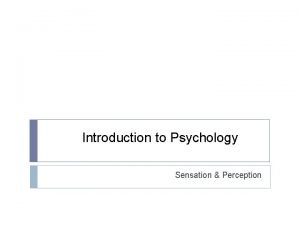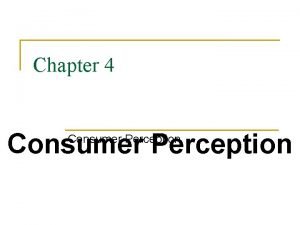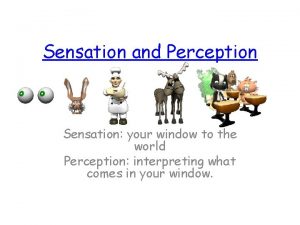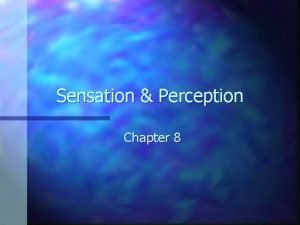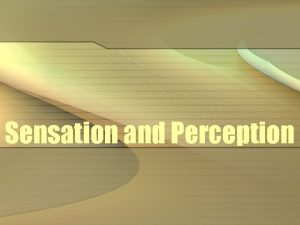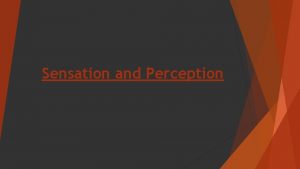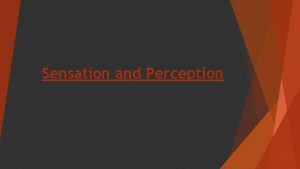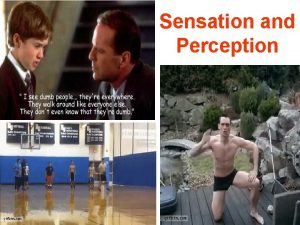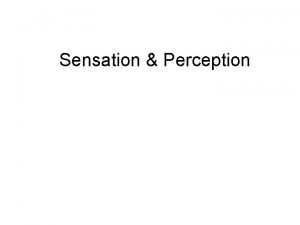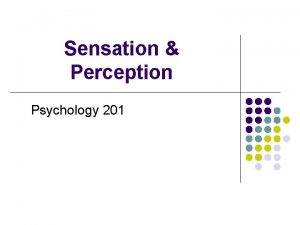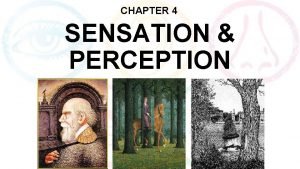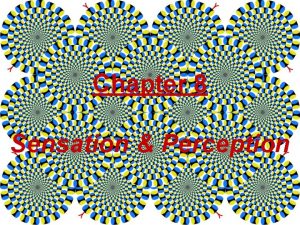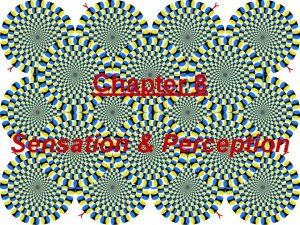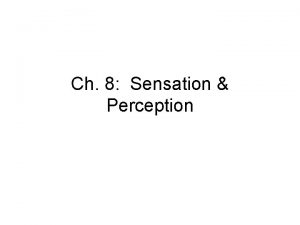SENSATION AND PERCEPTION DEFINITIONS Sensation The stimulation of













- Slides: 13

SENSATION AND PERCEPTION

DEFINITIONS Sensation � The stimulation of sensory receptors and the transmission of sensory information to the brain Stimulus � Any aspect of change in the environment to which an organism responds. Perception � The organization of sensory information into meaningful experiences.

THRESHOLDS What is a threshold? Absolute Threshold � The weakest amount of a stimulus required to produce a sensation 50 percent of the times presented. � Experiment

ABSOLUTE THRESHOLD EXAMPLES Vision � Seeing night. a candle flame from 30 miles away on a clear Audition � Hearing Taste � Tasting water. a watch ticking from 20 feet away. one teaspoon of sugar dissolved in 2 gallons of Smell � Smelling one drop of perfume in a 3 -room house Touch � Feeling a bee’s wing falling a distance of 1 centimeter onto your cheek.


SUBLIMINAL STIMULI When a stimulus intensity is below your absolute threshold, it is subliminal. Most commonly found as either visual stimuli or auditory stimuli. You are unaware of the stimuli, but your subconscious is and it can effect your behavior.

SUBLIMINAL MESSAGING Images � Subject would give more positive attributes to images of people after positive subliminal images rather than negative Face studies � Researchers will show subliminal images of happy or negative pictures. � Ask subjects to identify the emotion of a neutral face. Backtracking � Subliminal messages put into music, so when you play it backwards the message is recognizable.

DIFFERENCE THRESHOLD The minimum amount of difference a person can detect between two stimuli 50% of times tested. The Just Noticeable Difference (JND) is the smallest increase or decrease in the intensity of a stimulus that a person is able to detect. Weber’ Law � Different for every sense

SENSORY ADAPTATION When sensory receptors change their sensitivity to the stimulus. This phenomenon occurs in all senses, with the possible exception of the sense of pain. Advantages? ?

SIGNAL DETECTION THEORY There is no true absolute threshold for a stimulus, the threshold for a stimulus is different for every individual. Threshold is based upon: � Motivation � Experience � Expectations � Environment



WRAP UP Difference of Sensation and Perception Absolute and Difference Threshold Sensory Adaptation Signal Detection Theory
 Chapter 5 sensation and perception
Chapter 5 sensation and perception Visual perception gestalt principles
Visual perception gestalt principles Ap psych sensation and perception
Ap psych sensation and perception What is sensation and perception
What is sensation and perception Sensation and perception crossword review
Sensation and perception crossword review Chapter 3 sensation and perception
Chapter 3 sensation and perception Sensation and perception
Sensation and perception Chapter 6 sensation and perception
Chapter 6 sensation and perception Copyright ?
Copyright ? Consumer perception definition
Consumer perception definition Webers law
Webers law Sensation and perception
Sensation and perception Chapter 6 sensation and perception
Chapter 6 sensation and perception Chapter 6 sensation and perception
Chapter 6 sensation and perception




